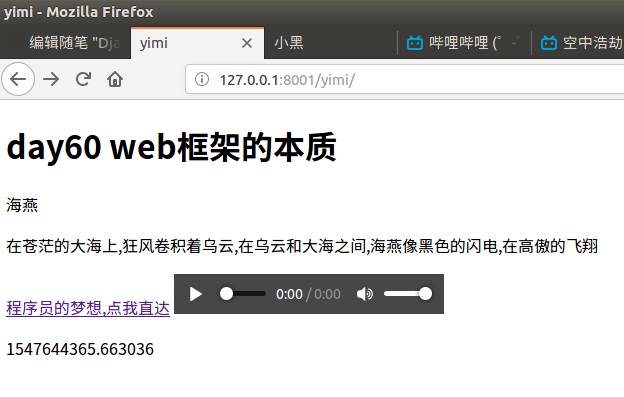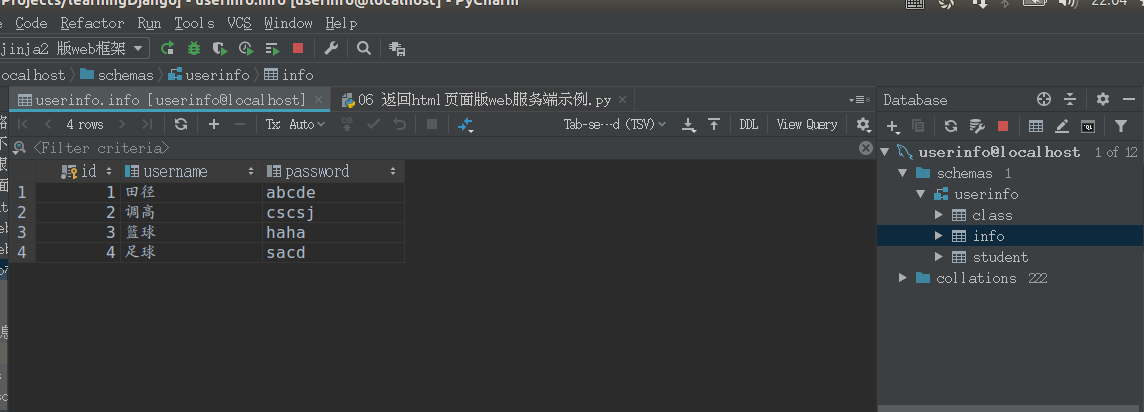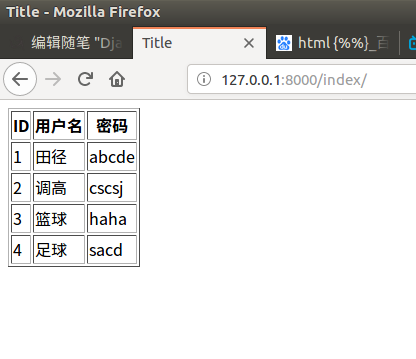day60
wsgiref比较稳定
""" 根据URL中不同的路径返回不同的内容--函数进阶版 返回HTML页面 让网页动态起来 wsgiref模块版 """ import time from wsgiref.simple_server import make_server # 将返回不同的内容部分封装成函数 def yimi(url): with open("yimi.html", "r", encoding="utf8") as f: s = f.read() now = str(time.time()) s = s.replace("@@xx@@", now) return bytes(s, encoding="utf8") def xiaohei(url): with open("xiaohei.html", "r", encoding="utf8") as f: s = f.read() return bytes(s, encoding="utf8") # 定义一个url和实际要执行的函数的对应关系 list1 = [ ("/yimi/", yimi), ("/xiaohei/", xiaohei), ] def run_server(environ, start_response): start_response('200 OK', [('Content-Type', 'text/html;charset=utf8'), ]) # 设置HTTP响应的状态码和头信息 url = environ['PATH_INFO'] # 取到用户输入的url 不用自己分割 func = None for i in list1: if i[0] == url: func = i[1] break if func: response = func(url) else: response = b"404 not found!" return [response, ] if __name__ == '__main__': httpd = make_server('127.0.0.1', 8090, run_server) print("我在8090等你哦...") httpd.serve_forever()
xiaohei.html、yimi.html和上一节内容相同。

=============================================================================================================================================
jinja2使用到数据库
from wsgiref.simple_server import make_server from jinja2 import Template def index(): with open("09 jinja2版web框架.html", "r", encoding="utf-8") as f: data = f.read()#打开html template = Template(data) # 生成模板文件 # 从数据库中取数据 import pymysql conn = pymysql.connect( host="127.0.0.1", port=3306, user="root", password="1×××××8", database="userinfo", charset="utf8", ) cursor = conn.cursor(cursor=pymysql.cursors.DictCursor) cursor.execute("select * from info;") user_list = cursor.fetchall() # 实现字符串的替换 ret = template.render({"user_list": user_list})#jinja2把数据填充到模板里面 渲染 用后面user_list替换data其中内容 return [bytes(ret, encoding="utf8"), ] def home():#用不到 with open("home.html", "rb") as f: data = f.read() return [data, ] # 定义一个url和函数的对应关系 URL_LIST = [ ("/index/", index), ("/home/", home), ] def run_server(environ, start_response): start_response('200 OK', [('Content-Type', 'text/html;charset=utf8'), ]) # 设置HTTP响应的状态码和头信息 url = environ['PATH_INFO'] # 取到用户输入的url func = None # 将要执行的函数 for i in URL_LIST: if i[0] == url: func = i[1] # 去之前定义好的url列表里找url应该执行的函数 break if func: # 如果能找到要执行的函数 return func() # 返回函数的执行结果 else: return [bytes("404没有该页面", encoding="utf8"), ] if __name__ == '__main__': httpd = make_server('', 8000, run_server) print("Serving HTTP on port 8000...") httpd.serve_forever()
jinja2版web框架.html
<!DOCTYPE html> <html lang="zh-CN"> <head> <meta charset="UTF-8"> <meta http-equiv="x-ua-compatible" content="IE=edge"> <meta name="viewport" content="width=device-width, initial-scale=1"> <title>Title</title> </head> <body> <table border="1"> <thead> <tr> <th>ID</th> <th>用户名</th> <th>密码</th> </tr> </thead> <tbody> {% for user in user_list %} <!--一行--> <tr> <td>{{user.id}}</td> <td>{{user.username}}</td> <td>{{user.password}}</td> </tr> {% endfor %} </tbody> </table> </body> </html>
数据库内容:

执行结果:
